A) Alice produces more pizzas and Betty produces more lemonade.
B) Alice produces more lemonade and Betty produces more pizzas.
C) Both Alice and Betty produce only pizzas.
D) There are no circumstances under which both Alice and Betty can benefit from specialization and trade.
Correct Answer

verified
Correct Answer
verified
Multiple Choice
Table 3-22
Assume that Zimbabwe and Portugal can switch between producing toothbrushes and producing hairbrushes at a constant rate. 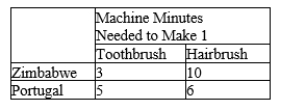 -Refer to Table 3-22. Suppose Zimbabwe decides to increase its production of toothbrushes by 10. What is the opportunity cost of this decision?
-Refer to Table 3-22. Suppose Zimbabwe decides to increase its production of toothbrushes by 10. What is the opportunity cost of this decision?
A) 0.3 hairbrush
B) 3 hairbrushes
C) 30 hairbrushes
D) 100 hairbrushes
Correct Answer

verified
Correct Answer
verified
Multiple Choice
A production possibilities frontier is a straight line when
A) the more resources the economy uses to produce one good, the fewer resources it has available to produce the other good.
B) an economy is interdependent and engaged in trade instead of self-sufficient.
C) the rate of tradeoff between the two goods being produced is constant.
D) the rate of tradeoff between the two goods being produced depends on how much of each good is being produced.
Correct Answer

verified
Correct Answer
verified
Multiple Choice
Table 3-18
The following table contains some production possibilities for an economy for a given month.  -Refer to Table 3-18. If the production possibilities frontier is bowed outward, then "?" could be
-Refer to Table 3-18. If the production possibilities frontier is bowed outward, then "?" could be
A) 150.
B) 225.
C) 300.
D) 375.
Correct Answer

verified
Correct Answer
verified
Multiple Choice
Figure 3-5
Hosne's Production Possibilities Frontier
Merve's Production Possibilities Frontier 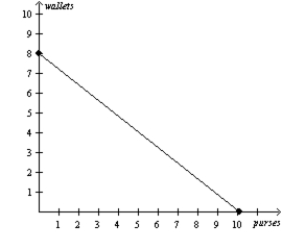
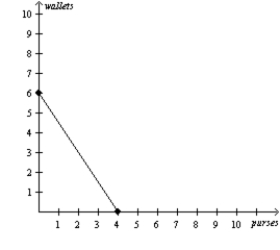 -Refer to Figure 3-5. If the production possibilities frontier shown for Merve is for 8 hours of work, then how long does it take Merve to make one purse?
-Refer to Figure 3-5. If the production possibilities frontier shown for Merve is for 8 hours of work, then how long does it take Merve to make one purse?
A) 1/2 hour
B) 2 hours
C) 4 hours
D) 8 hours
Correct Answer

verified
Correct Answer
verified
Multiple Choice
Table 3-24
Assume that England and Spain can switch between producing cheese and producing bread at a constant rate.

-Refer to Table 3-24. Assume that England and Spain each has 40 labor hours available. Originally, each country divided its time equally between the production of cheese and bread. Now, each country spends all its time producing the good in which it has a comparative advantage. As a result, the total output of cheese increased by
-Refer to Table 3-24. Assume that England and Spain each has 40 labor hours available. Originally, each country divided its time equally between the production of cheese and bread. Now, each country spends all its time producing the good in which it has a comparative advantage. As a result, the total output of cheese increased by
A) 15.
B) 20.
C) 25.
D) 40.
Correct Answer

verified
Correct Answer
verified
Multiple Choice
Figure 3-18
Bintu's Production Possibilities Frontier
Juba's Production Possibilities Frontier 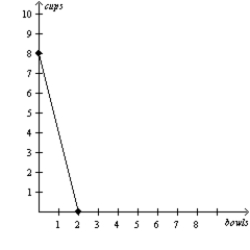
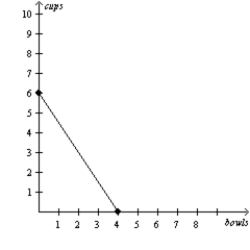 -Refer to Figure 3-18. The opportunity cost of 1 bowl for Juba is
-Refer to Figure 3-18. The opportunity cost of 1 bowl for Juba is
A) 1/4 cup.
B) 2/3 cup.
C) 3/2 cups.
D) 4 cups.
Correct Answer

verified
Correct Answer
verified
Multiple Choice
Table 3-3
Production Opportunities 
-Refer to Table 3-3. We could use the information in the table to draw a production possibilities frontier for England and a second production possibilities frontier for France. If we were to do this, measuring cheese along the horizontal axis, then
-Refer to Table 3-3. We could use the information in the table to draw a production possibilities frontier for England and a second production possibilities frontier for France. If we were to do this, measuring cheese along the horizontal axis, then
A) the slope of England's production possibilities frontier would be -4 and the slope of France's production possibilities frontier would be -0.4.
B) the slope of England's production possibilities frontier would be -0.25 and the slope of France's production possibilities frontier would be -2.5.
C) the slope of England's production possibilities frontier would be 0.25 and the slope of France's production possibilities frontier would be 2.5.
D) the slope of England's production possibilities frontier would be 4 and the slope of France's production possibilities frontier would be 0.4.
Correct Answer

verified
Correct Answer
verified
True/False
If a country has the comparative advantage in producing a product, then that country must also have the absolute advantage in producing that product.
Correct Answer

verified
Correct Answer
verified
Multiple Choice
Table 3-3
Production Opportunities 
-Refer to Table 3-3. Which of the following combinations of cheese and wine could England not produce in 40 hours?
-Refer to Table 3-3. Which of the following combinations of cheese and wine could England not produce in 40 hours?
A) 12 units of cheese and 7 units of wine
B) 16 units of cheese and 6 units of wine
C) 20 units of cheese and 5 units of wine
D) 26 units of cheese and 4 units of wine
Correct Answer

verified
Correct Answer
verified
True/False
Zora can produce 4 quilts in a week and she can produce 1 corporate website in a week. Lou can produce 9 quilts in a week and he can produce 2 corporate websites in a week. Zora has the comparative advantage in quilts and the absolute advantage in neither good, while Lou has the comparative advantage in corporate websites and the absolute advantage in both goods.
Correct Answer

verified
Correct Answer
verified
Multiple Choice
A country that currently does not trade with other countries could benefit by
A) restricting imports and promoting exports.
B) promoting imports and restricting exports.
C) restricting both imports and exports.
D) not restricting trade.
Correct Answer

verified
Correct Answer
verified
True/False
Jake can complete an oil change in 45 minutes and he can write a poem in 90 minutes. Ming-la can complete an oil change in 30 minutes and she can write a poem in 90 minutes. Jake's opportunity cost of writing a poem is lower than Ming-la's opportunity cost of writing a poem.
Correct Answer

verified
Correct Answer
verified
Multiple Choice
The most obvious benefit of specialization and trade is that they allow us to
A) work more hours per week than we otherwise would be able to work.
B) consume more goods than we otherwise would be able to consume.
C) spend more money on goods that are beneficial to society, and less money on goods that are harmful to society.
D) consume more goods by forcing people in other countries to consume fewer goods.
Correct Answer

verified
Correct Answer
verified
Multiple Choice
Table 3-14
Assume that Nick and Faldo can switch between producing wheat and producing cloth at a constant rate.  -Refer to Table 3-14. Assume that Nick and Faldo each has 2 hours available. If each person divides his time equally between the production of wheat and cloth, then total production is
-Refer to Table 3-14. Assume that Nick and Faldo each has 2 hours available. If each person divides his time equally between the production of wheat and cloth, then total production is
A) 8 bushels of wheat and 15 yards of cloth.
B) 14 bushels of wheat and 27 yards of cloth.
C) 16 bushels of wheat and 30 yards of cloth.
D) 28 bushels of wheat and 34 yards of cloth.
Correct Answer

verified
Correct Answer
verified
True/False
When each person specializes in producing the good in which he or she has a comparative advantage, each person can gain from trade but total production in the economy is unchanged.
Correct Answer

verified
Correct Answer
verified
Short Answer
Table 3-41
 -Refer to Table 3-41. If the two countries decide to trade with each other, which country should specialize in producing compasses?
-Refer to Table 3-41. If the two countries decide to trade with each other, which country should specialize in producing compasses?
Correct Answer

verified
Correct Answer
verified
Multiple Choice
Table 3-21
Assume that Jamaica and Norway can switch between producing coolers and producing radios at a constant rate. The following table shows the number of coolers or number of radios each country can produce in one day. 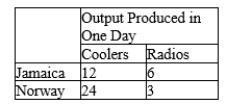 -Refer to Table 3-21. Suppose Jamaica decides to increase its production of radios by 12. What is the opportunity cost of this decision?
-Refer to Table 3-21. Suppose Jamaica decides to increase its production of radios by 12. What is the opportunity cost of this decision?
A) 3 coolers
B) 6 coolers
C) 12 coolers
D) 24 coolers
Correct Answer

verified
Correct Answer
verified
True/False
In one month, Moira can knit 2 sweaters or 4 scarves. In one month, Tori can knit 1 sweater or 3 scarves. Together, they could produce more output in total if Moira knits only sweaters and Tori knits only scarves.
Correct Answer

verified
Correct Answer
verified
Multiple Choice
Suppose the U.S. and Japan can both produce airplanes and televisions and the U.S. has a comparative advantage in the production of airplanes while Japan has a comparative advantage in the production of televisions. Also suppose the U.S. has an absolute advantage in the production of both airplanes and televisions. The U.S. should
A) not trade airplanes or televisions with Japan.
B) import airplanes from Japan and export televisions to Japan.
C) export airplanes to Japan and import televisions from Japan.
D) export both airplanes and televisions to Japan.
Correct Answer

verified
Correct Answer
verified
Showing 521 - 540 of 547
Related Exams